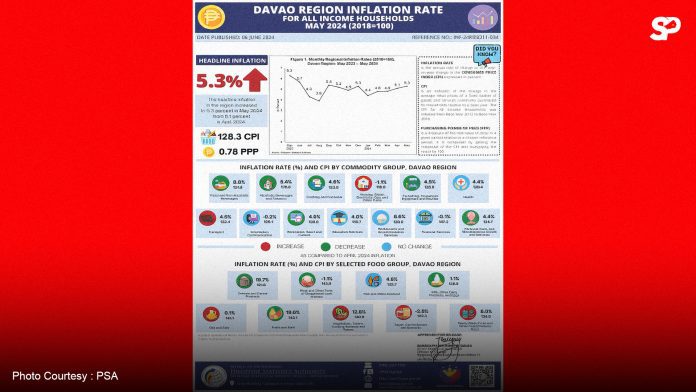By Sam Ramos
The inflation rate in the Davao Region slowed to 2.8% in September, marking a significant drop from 4.9% in August, according to a report from the Philippine Statistics Authority in Davao Region (PSA-11) released on Wednesday. The region’s inflation rate was notably higher at 5.4% in the same month last year. The PSA-11 attributes this downward trend primarily to a reduction in food and non-alcoholic beverage price increases, which decelerated to 4.3% in September from 6.6% in August. This decline reflects the national effort to stabilize food prices amid fluctuations in supply due to recent adverse weather events and other factors impacting production and distribution.
Other commodity groups also contributed to the easing inflation, with the annual increase in prices for housing, water, electricity, gas, and other fuels dropping to 1.8%, while transportation costs continued to decline, falling by 3.9%. Several other categories experienced a slower rise in prices, including alcoholic beverages and tobacco, which eased to 4.3% from 5.0%, clothing and footwear, which decreased to 4.2% from 4.5%, and furnishings, household equipment, and routine household maintenance, which also fell to 4.3% from 4.5%.
Similarly, inflation rates in health services, recreational activities, education services, restaurants, and personal care services all showed slight declines, indicating a broad-based reduction in price growth across the region. The food sector, a key driver of regional inflation, saw marked improvements, with inflation in cereals and cereal products dropping to 4.6% from a high of 15.0%. Meanwhile, prices for vegetables, tubers, and pulses stabilized, with no increase from the previous month, down from a 7.0% rise in August. Meat prices also saw a modest reduction, falling to 1.8% from 2.1%. Information and communication services (-0.4%) and financial services (-0.1%) held steady, indicating no price changes in these sectors from August.
The inflation decline in Davao Region aligns with the nationwide easing of inflation observed in recent months, a trend largely attributed to government measures aimed at moderating price increases in basic commodities and essential services.

